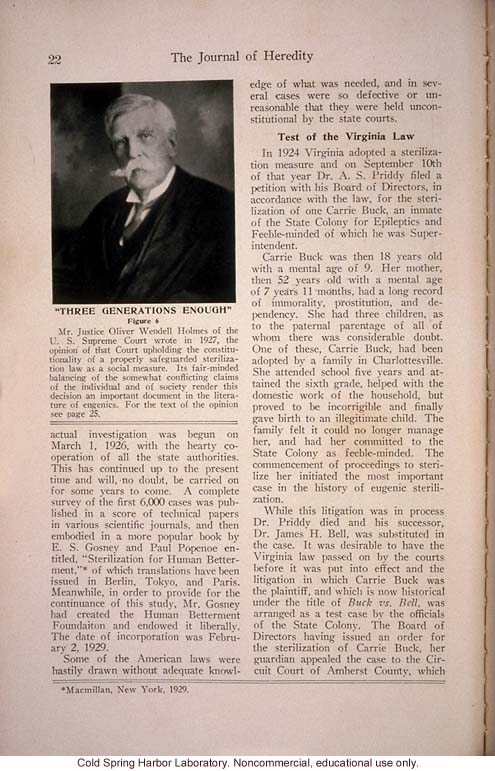22 The Journal of Heredity
[photo]
"Three Generations Enough"
Figure 6
Mr. Justice Oliver Wendell Holmes of the U. S. Supreme Court wrote in 1927, the opinion of the Court upholding the constitutionality of a properly safeguarded sterilization law as a social measure. Its fair-minded balancing of the somewhat conflicting claims of the individual and of society render this decision an important document in the literature of eugenics. For the text of the opinion see page 25.
[double score, column width]
actual investigation was begun on March 1, 1926, with the hearty co-operation of all the state authorities. This has continued up to the present time and will, no doubt, be carried on for some years to come. A complete survey of the first 6,000 cases was published in a score of technical papers in various scientific journals, and then embodied in a more popular book by E. S. Gosney and Paul Popenoe entitled, "Sterilization for Human Betterment,"* of which translations have been issued in Berlin, Tokyo, and Paris. Meanwhile, in order to provide for the continuance of the study, Mr. Gosney had created the Human Betterment Foundation and endowed it liberally. The date of incorporation was February 2, 1929.
Some of the American laws were hastily drawn without adequate knowledge of what was needed, and in several cases were so defective or unreasonable that they were held unconstitutional by the state courts.
[bold]Test of the Virginia Law[end bold]
In 1924 Virginia adopted a sterilization measure and on September 10th of that year Dr. A. S. Priddy filed a petition with his Board of Directors, in accordance with the law, for the sterilization of one Carrie Buck, an inmate of the State Colony for Epileptics and Feeble-minded of which he was Superintendent.
Carrie Buck was then 18 years old with a mental age of 9. Her mother, than 52 years old with a mental age of 7 years 11 months, had a long record of immorality, prostitution, and dependency. She had three children, as to the paternal parentage of all of whom there was considerable doubt. One of these, Carrie Buck, had been adopted by a family in Charlottesville. She attended school five years and attained the sixth grade, helped with the domestic work of the household, but proved to be incorrigible and finally gave birth to an illegitimate child. The family felt it could no longer manage her, and had her committed to the State Colony as feeble-minded. The commencement of the proceedings to sterilize her initiated the most important case in the history of eugenic sterilization.
While this litigation was in process Dr. Priddy died and his successor, Dr. James H. Bell, was substituted in the case. It was desirable to have the Virginia law passed on by the courts before it was put into effect and the litigation in which Carrie Buck was the plaintiff, and which is now historical under the title of [italics]Buck vs Bell,[end italics] was arranged as a test case by the officials of the State Colony. The Board of Directors having issued an order for the sterilization of Carrie Buck, her guardian appealed the case to the Circuit Court of Amherst County, which
[page width double score]
*Macmillan, New York, 1929.
[end]


